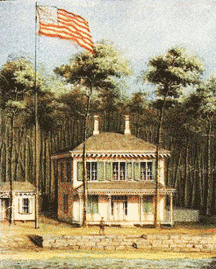On Memorial Day —
Remember the future
by Elizabeth Ayres
Like a bayonet brandished against the tide, the long, thin peninsula that is St. Mary’s County tapers to a sharp tip at Point Lookout, where the Potomac River meets Chesapeake Bay. When I visited in early March, the day itself was at arms. A tearing wind flattened beach grasses and twisted tree branches. Clouds heaped in the sky like heavy, gray boulders. An angry white surf clawed at the sand. Small wonder that the elements assail each other there, given the history of the place.
During the American Revolution, it was a lookout whence spies reported on the British fleet. Next came the lighthouse. Next there came the resort, with a hotel, wharf and cottages. Pleasure seekers vanished when the Civil War erupted, so next came the hospital, built to treat Union soldiers, then expanded to incarcerate ever-increasing numbers of Confederate wounded. Next there came the prisoner of war camp, but the prisoners needed guarding, so three forts were built, and in the midst of it all, a contraband camp evolved, refuge for African Americans escaping from southern captivity to northern liberty.
Such bald, bare facts. But what about the lives torn, flattened, twisted? Some 5,000 men, women and children died at Point Lookout. In Hammond Hospital, with its 16 spoke-like wings, its 1,400 beds a revolving wheel of pain for those laid low by bullets, bombs, shrapnel, disease. In Camp Hoffman. Over the course of two short years, 52,000 Confederate soldiers were walled up there, living in tents, with scant rations, in every extreme of weather, suffering from malaria, dysentery, smallpox. In the Contraband Camp, where hungry, frightened folk burrowed their dens in the damp earth “like beasts of the field,” said one appalled nurse.
And in the forts? That day in March, I roamed through the reconstructed barracks of Fort Lincoln. Thin plank walls kept the wind out, but not the cold. In summer, it would have been an oven. I imagine I am a soldier of the 5th Regiment, stationed here as guard. I peer through the window, out over the earthen ramparts, to the Potomac flowing freely under an open sky. Home is somewhere out there, my wife, my children, my ease. Duty has brought me to this place of constant worry. Is that the wind roaring or cannon fire? Waves on sand or the enemy’s boots? It’s gall I eat with my daily bread, this perpetual fear of attack.
In 1867, Nella Sweet published a hymn, “Kneel Where Our Loves are Sleeping,” dedicated “To the Ladies of the South who are Decorating the Graves of the Confederate Dead.” This grassroots ritual morphed into Decoration Day, when flowers were placed on the graves of Union and Confederate soldiers, then morphed again into Memorial Day, which honors Americans who have died fighting in any war. Perhaps we’ll call it something else in the future, if we ever wake up long enough to realize: All our loves lie sleeping somewhere; this whole planet should be festooned with flowers.
That blustery afternoon in late winter, I met Bob, a member of the group that’s been restoring Point Lookout’s historical sites. Two of Bob’s ancestors were imprisoned in Camp Hoffman, and he served in Vietnam. We spoke of war, and duty, and I wandered off, down to the beach, where I found a clutch of feathers, the tattered remains of some unlucky bird’s free flight. I thought, on my mother’s side, my Georgia forebearers could be buried here; on my father’s side, my German Jewish kin could be buried at Dachau; if I had children, they might be dying in Iraq. That’s when it came to me, we are all prisoners of war, and according to the Geneva Convention, it’s our duty to escape.
May 26 is Memorial Day. Would it not honor those who have died in our wars, to spend one moment contemplating peace? Peer through the window, over the ramparts? It’s somewhere out there, and the taste of bread without the gall, if only we could fly free of this place where, just now, we all seem to be stationed.
Poet and writing teacher Elizabeth Ayres (CreativeWritingCenter.com) is the author of Writing the Wave and Know the Way. Her last reflection for Bay Weekly was Gallivanting on a Good Friday Full Moon: http://www.bayweekly.com/old-site/year08/issuexvi12/reflectxvi12.html. Listen for her radio program, Soundings, Saturday evenings from 6 to 6:30pm. Tune into WRYR 97.5 FM or catch it on the web at www.wryr.org.